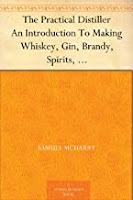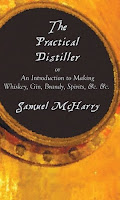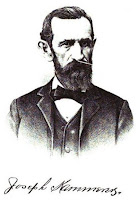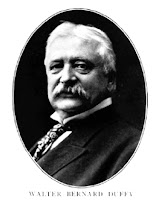Sam McHarry and His Distilling Guide for the Ages
 In 1809 when Samuel McHarry wrote his book, “The Practical Distiller,” he was apologetic. In pursuing his own distilling efforts, he said, he could find little help from practitioners or in print: “Could I have witnessed the publication of a similar work by a man of science and education, mine should never have appeared.” The jottings of this farmer from Lancaster, Pennsylvania, not only was published, it apparently has never been out of print. A dozen different covers from ensuing years of publication, reproduced below, attest to its longevity.
In 1809 when Samuel McHarry wrote his book, “The Practical Distiller,” he was apologetic. In pursuing his own distilling efforts, he said, he could find little help from practitioners or in print: “Could I have witnessed the publication of a similar work by a man of science and education, mine should never have appeared.” The jottings of this farmer from Lancaster, Pennsylvania, not only was published, it apparently has never been out of print. A dozen different covers from ensuing years of publication, reproduced below, attest to its longevity.
Although McHarry had a lot to say about the state of distilling, he was silent on why he decided to make alcohol from the rich grain and fruit lands that are Lancaster County. My assumption is that his farm was producing more output than he could feed to livestock or easily sell. It also was abundantly clear that a gallon of whiskey could fetch as much money as ten bushels of rye grain.
 McHarry’s silence on “why” is more than made up by his distain for American distillers. He deplored “the circumstance of so many knaves, blockheads and conceited characters being engaged in the business” and describes his own futile efforts to learn from a highly regarded local distiller only to find out that the man had no idea why the quality and quantity of his runs differed sharply from day to day. He inquired of other distillers, some of whom attributed whiskey variability to “witchcraft.”
McHarry’s silence on “why” is more than made up by his distain for American distillers. He deplored “the circumstance of so many knaves, blockheads and conceited characters being engaged in the business” and describes his own futile efforts to learn from a highly regarded local distiller only to find out that the man had no idea why the quality and quantity of his runs differed sharply from day to day. He inquired of other distillers, some of whom attributed whiskey variability to “witchcraft.”
Nor could McHarry find any written material on the subject: “To my surprise, after a diligent search of all the book-stores and catalogues in Pennsylvania I found there was no American work extant, treating on this science….” European manuals he found at variance with American “habits, customs, and mode of economy.”
 As a result, after years of working things out “from scratch” for himself, McHarry decided to write his own distiller’s handbook. In this endeavor, he had the expert help of John Wyeth of Harrisburg, Pennsylvania, a journalist, and experienced publisher whose presses had printed numerous books with a Pennsylvania flavor that were said to be “extremely popular and extremely profitable.” Approached by McHarry, Wyeth enthusiastically agreed to publication and likely supplied needed editorial services to McHarry’s manuscript. Thus in 1809, “The Practical Distiller,” shown here, saw its first edition. It would not be the last.
As a result, after years of working things out “from scratch” for himself, McHarry decided to write his own distiller’s handbook. In this endeavor, he had the expert help of John Wyeth of Harrisburg, Pennsylvania, a journalist, and experienced publisher whose presses had printed numerous books with a Pennsylvania flavor that were said to be “extremely popular and extremely profitable.” Approached by McHarry, Wyeth enthusiastically agreed to publication and likely supplied needed editorial services to McHarry’s manuscript. Thus in 1809, “The Practical Distiller,” shown here, saw its first edition. It would not be the last.
The “do-it-yourself” manual was advertised as “An introduction to making WHISKEY, GIN, BRANDY, SPIRITS, etc…from the produce of the United States: Such as RYE, CORN, BUCK-WHEAT, APPLES, PEACHES, POTATOES, PUMPIONS [pumpkins], and TURNIPS.” In other words, if a grain or fruit could produce alcohol, McHarry would show you how to turn it into booze.
In his chapter on distilling whiskey, McHarry described four different recipes, one of all rye grain, a second two-thirds rye and one-third corn, a third half rye and half corn, but his recommended mix was one-third rye and two-thirds corn: “That corn has as much and as good whiskey as rye or any other grain, cannot be disputed.” That, however, was not why McHarry favored this recipe. Always looking at the “bottom line” of profitability, he contended that the spent mash or “slop” from this mix was “Much superior to that of any other grain for feeding or fattening either horned cattle or hogs….” Fatter hogs meant a fatter payday.
Again with an eye to profit, McHarry contended that it should be possible, given good grain, pure water, and suitable weather to eke four gallons of whiskey out of a single bushel of grain. (Later, whiskey scientist Dr. James Crow would decree not more than 1.5 gallons per bushel.) The Lancaster County farmer also included advice on transporting whiskey to market. He calculated that a distiller who sent a wagon load of 300 gallons of whiskey worth $150 to buyers seventy miles away would pay an $18 hauling cost. If found upon arrival and inspection to be both under-proof and having lost volume, the whiskey might fetch only $105, a loss of $27, more than $600 in today’s dollar. McHarry’s lesson: Be sure of proof and tight barrels.
McHarry also recommended distilling potatoes. Although nowhere does he mention vodka, he contended that potatoes made “a very good spirit” that might substitute for brandy or rum. Morever, potatoes were cheaper to grow than rye and would be “a source of profit…, encouragement to the farmer, and be of benefit to our country at large.” McHarry followed his recipe for potatoes by suggesting it could be adapted to pumpkins and turnips. Of turnips, however, he warned that they “will produce nearly as much spirits as potatoes, but not so good.”
Following chapters of “The Practical Distiller” contain advice on making various types of wine and beer. Nowhere in the volume, however, do we learn anything about McHarry’s personal life. We know he was born in Lancaster County about 1785, just two years after the end of the Revolutionary War. His father, Alexander, who spelled his name “Maharry,” was an immigrant from Ireland and a farmer. His mother was Ann Robesson, of Pennsylvania stock. She was 30 at Samuel’s birth; Alexander was 31. McHarry had one brother, William, born in Leacock, Pennsylvania, when Sam was one year old. The distiller/author apparently never married. He died in 1843 when he was 58 years old. I have been unable to identify his place of interment.
McHarry lives on in the book published in 1809, a work that to my knowledge has never been out of print. Every succeeding generation, it would seem, has been interested in “home” distilling and a raft of publishers with no copyright to worry about have rushed to put McHarry’s recipes and advice into print. In January 2008, an original leather-covered copy, shown above, sold at auction considerably above estimate at $4,800.
Note: More recently another original copy of “The Practical Distiller,” said to be “in delicate condition” and bearing some water stains went up for sale at $2,500. This copy had the additional provenance of being originally owned by John Hoge, an early Pennsylvania settler and Revolutionary War soldier. Hoge is believed to have run a tavern in Washington, Pennsylvania.













































.jpg%20-%20C%20.jpg)



















































